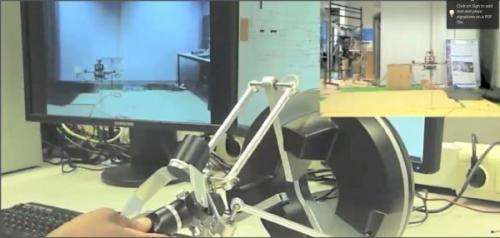New generation of aerial robots for high-risk service tasks

The need for robots able to carry out high-risk service tasks, such as the inspection of power plants and the cleaning of skyscrapers, is growing. Robots that actively interact with the environment without being constrained on the ground are extremely well suited to such tasks. Doctoral candidate Abeje Yenehun Mersha designed novel human-in-the-loop control architectures for this new and advanced generation of aerial service robots. Mr. Mersha is affiliated with the CTIT research institute of the University of Twente. He is due to obtain his doctoral degree on Friday June 13th.
Abeje Yenehun Mersha's research focuses mainly on the teleoperation of aerial service robots. These types of robots are poised to be fundamental parts of tomorrow's service applications for their low-cost, safety, and efficiency. These robots support humans in performing various tasks that require the ability to actively interact with remote environments while staying airborne.
An extension of the operator
Mersha developed different teleoperation control architectures that allow an operator to remotely supervise an aerial service robot while performing a complex service task. Mersha explains: "The human operator does not need be a trained pilot to operate the aerial robot, but an expert in the required service task. The aerial robot can be seen as an extension of the operator's own hand, which is being remotely controlled in a cluttered environment by using a haptic device." Mersha continues: "The overall teleoperation control architecture should guarantee a stable behavior both during the free-flight of the aerial robot and during the interaction with the remote environment, while guaranteeing a good level of transparency even in the presence of time-delays and other network-induced imperfections".
Multi-modal haptic feedback
Control strategies that rely upon a cooperative and adaptive interaction between the on-board automatic control of the aerial robot and the human operator, are essential for the accomplishment of service tasks. In the case of traditional aerial robots, the operator becomes aware of the states of the autonomous aerial robot through camera images (visual feedback). However, due to the complexity of the service tasks, this form of feedback alone might not be adequate. Through a haptic device, used to bilaterally interact with the remotely controlled aerial robot, operators are now able to actually feel how the task is progressing. So, for example, if the robot interacts with the environment and is no longer able to move forward, the operator feels a resistance in the form of an opposing force via the haptic interface. As such, the operator feels like he is actually interacting with the remote environment directly. Moreover, having received this force feedback, together with other feedbacks, such as vision and vibro-tactile information, the awareness of the operator significantly increases. This helps the operator to make a better decision in order to accomplish the task effectively and efficiently.
Time delay
Mersha carried out a variety of simulations and experiments in order to test the theory in practice. Among others, he carried out the longest intercontinental haptic teleoperation of aerial robots in cooperation with the Australian National University to assess his solution for dealing with time delays and other network-induced imperfections. The experiment involved an operator located in Enschede, The Netherlands, flying an aerial service robot in Canberra, Australia, that performs a maneuvering task in cluttered environment while avoiding obstacles. The short film shows the experiment.
Provided by University of Twente



















